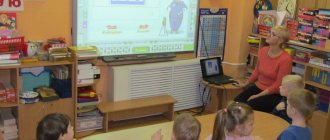Health-saving technologies in the educational process
Currently, medical workers note a significant decrease in the number of absolutely healthy children, a rapid increase in the number of functional disorders and chronic diseases, a sharp increase in the proportion of pathologies of the nervous system, cardiovascular and digestive systems, and the musculoskeletal system.
There is a significant deterioration in the health of children associated with an increase in the volume and complexity of the educational workload, the complication of the nature of the “student-teacher” relationship, lack of physical activity, poor nutrition of students, non-compliance with hygienic requirements in the organization of the educational process, lack of basic knowledge among students about how to become healthy [3].
In this regard, one of the activities of a modern school is to preserve the health of schoolchildren. For this purpose, health-saving technologies are used, which involve a combination of pedagogical, psychological and medical influences aimed at protecting and ensuring health, and forming a valuable attitude towards it.
A healthy lifestyle does not yet occupy first place in the hierarchy of human needs and values in our society. But if we organize an educational environment based on health-saving technologies, teach children from a very early age to value, take care of and strengthen their health, if we demonstrate a healthy lifestyle by personal example, then only in this case can we hope that future generations will be healthier and developed not only personally, intellectually, spiritually, but also physically.
The health of a child, his socio-psychological adaptation, normal growth and development are largely determined by the environment in which he lives. For a child from 6 to 17 years old, this environment is the education system, since more than 70% of his waking time is associated with being in educational institutions. At the same time, during this period the most intensive growth and development occurs, the formation of health for the rest of life, the child’s body is most sensitive to exogenous environmental factors.
According to the Institute of Developmental Physiology of the Russian Academy of Education, the school educational environment creates risk factors for health problems, the action of which is associated with 20-40% of the negative influences that worsen the health of school-age children. Research by the Institute of VF RAO makes it possible to rank school risk factors in descending order of importance and strength of influence on the health of students:
- stressful pedagogical tactics;
- inconsistency of teaching methods and technologies with the age and functional capabilities of schoolchildren;
- failure to comply with basic physiological and hygienic requirements for organizing the educational process;
- insufficient literacy of parents in matters of maintaining children's health;
- failures in the existing system of physical education;
- intensification of the educational process;
- functional illiteracy of the teacher in matters of health protection and promotion;
- partial destruction of school medical control services;
- lack of systematic work to develop the value of health and a healthy lifestyle.
Thus, the traditional organization of the educational process creates constant stress overloads in schoolchildren, which lead to breakdown of the mechanisms of self-regulation of physiological functions and contribute to the development of chronic diseases. As a result, the existing school education system is health-costly.
Many teachers believe that administrators and specially trained professionals should be involved in preserving and strengthening the health of students at school. However, an analysis of school risk factors shows that the majority of students’ health problems are created and solved during the daily practical work of teachers, i.e., associated with their professional activities. Therefore, the teacher needs to find reserves for his own activities in preserving and strengthening the health of students.
The lesson remains the main organizational form of the educational process, which directly depends on the teacher. Identifying criteria for the health-saving potential of a school lesson and building a lesson on a health-saving basis is the most important condition for overcoming the health-intensive nature of school education.
“Health-forming educational technologies”, as defined by N.K. Smirnov, are all those psychological and pedagogical technologies, programs, methods that are aimed at nurturing in students a culture of health, personal qualities that contribute to its preservation and strengthening, the formation of an idea of health as values, motivation to lead a healthy lifestyle.
Health-saving technology, according to V.D. Sonkin, is:
- conditions for a child’s education at school (lack of stress, adequacy of requirements, adequacy of teaching and upbringing methods);
- rational organization of the educational process (in accordance with age, gender, individual characteristics and hygiene requirements);
- compliance of educational and physical activity with the age capabilities of the child;
- necessary, sufficient and rationally organized motor mode.
Health-saving educational learning technologies include the following components:
- optimal level of difficulty, variability of teaching methods and forms;
- optimal combination of motor and static loads;
- small group training;
- use of clarity;
- a combination of different forms of information provision;
- creating an emotionally favorable atmosphere;
- formation of motivation to study;
- Cultivating students' knowledge on health issues.
Health-saving technology in the educational process involves organizing training through:
- different channels of information perception (vision, hearing, sensation) depending on the age characteristics of students, as well as the goals and objectives of the lesson;
- creating a health-saving classroom space;
- knowledge of weekly performance zones and planning lessons of varying degrees of difficulty;
- knowledge about the levels of performance of students during the working day;
- planning tests, lessons of new material, generalization lessons, depending on the place of the lesson in the schedule grid;
- distribution of intensity of mental load during the lesson and working day.
Health-saving technologies use the following methods:
- frontal;
- group;
- practical;
- educational game;
- situational method;
- game method;
- competitive;
- active learning methods.
The following techniques are used in health-saving technologies:
- protective and preventive;
- compensatory-neutralizing;
- stimulating;
- informational and educational.
The effectiveness of the analysis of health-saving activities in school depends on methodological and methodological approaches and is built on the principles developed over the previous decades at the Institute of Developmental Physiology of the Russian Academy of Education, namely:
- complexity;
- consistency;
- integrity;
- dynamism (repetition);
- representativeness;
- methodological unity.
Comprehensiveness implies the simultaneous coverage of a wide range of indicators that reflect both the state of the educational environment and personal data characterizing the level and nature of academic and extracurricular workload, as well as the individual adaptive capabilities of the student. Systematicity means the analysis of not only the qualitative and quantitative indicators of the activities of an educational institution, but also (and primarily) the relationships between them, reflecting the structure and effectiveness of the health-preserving activities of an educational institution.
Integrity is a necessary condition for a complete data analysis, implying a comprehensive presentation of the results for each educational institution.
Dynamism (repetition) implies repeated (twice a year - autumn and spring; over a number of years) examination of the same educational institutions, student populations, specific students.
Representativeness (representation) is determined by the requirements of statistics, according to which the reliability of findings and conclusions depends on the size of the sample studied. Representativeness is achieved by surveying sufficiently large populations of students.
Methodological unity is an indispensable condition for the comparability of data obtained at different stages of the study, in different regions, in different educational institutions.
Among the health-saving technologies used in the education system, several groups can be distinguished, which use different approaches to health protection, and, accordingly, different methods and forms of work:
— medical and hygienic technologies (MHT); — physical education and health technologies (PHT); — environmental health-saving technologies (ECT); — technologies for ensuring life safety (LHS); — health-saving educational technologies (HET);
There are other grounds for classifying health-saving technologies. Based on the nature of their action, they can be divided into the following groups:
— protective and preventive; - compensatory-neutralizing; - stimulating; — informational and educational.
The most generalized possible classification is the identification of two types of health-saving technologies - organizational and pedagogical.
The system-forming principle of health-saving pedagogy is the priority of caring for the health of students, within which we can highlight such mandatory conditions as scientific and methodological support for work, selection and training of teaching staff (including care for their health) and, finally, sufficient financial support for the entire project .
Health-saving educational technologies can be divided into three subgroups:
— organizational and pedagogical technologies (OPT), which determine the structure of the educational process, partially regulated in SanPiN, helping to prevent states of overfatigue and physical inactivity;
— psychological and pedagogical technologies (PPT), associated with the direct work of the teacher in the lesson, the impact that he has on his students for all 45 minutes; This also includes psychological and pedagogical support for all elements of the educational process;
— educational and educational technologies (ET), which include programs for teaching competent care of one’s health and creating a culture of health for students, motivating them to lead a healthy lifestyle, preventing bad habits, also providing for organizational and educational work with schoolchildren after school, education their parents.
Health-saving technologies in the work of an individual teacher can be represented as a systemically organized combination of the principles of cooperation pedagogy, “effective” pedagogical techniques, elements of pedagogical skill aimed at achieving optimal psychological adaptation of the student to the educational process, caring for the preservation of his health and education him as a personal example of a culture of health.
A teacher who is ready to use health-saving educational technologies in his work, at the first stage in this regard, faces the following tasks:
— an objective assessment of one’s strengths and weaknesses related to professional activity, drawing up a plan for the necessary self-correction and its implementation;
— necessary advanced training on health issues, health-saving technologies;
— revision of the pedagogical methods and techniques used in their work in terms of their expected impact on the health of students;
— purposeful implementation of health-saving educational technologies during training sessions and extracurricular work with students, monitoring the results obtained, both according to one’s own feelings and using objective assessment methods;
— to promote the formation of a health-preserving educational environment in your educational institution as an effective interaction between all members of the teaching staff, students and their parents to create conditions and implement programs aimed at preserving, developing and strengthening health.
Thus, the main task of implementing health-saving technologies is to organize the educational process at all levels, in which high-quality training, development and education of students are not accompanied by damage to their health.
Observations show that the use of health-saving technologies in the educational process allows students to more successfully adapt to the educational and social space, to reveal their creative abilities, and for the teacher to effectively prevent antisocial behavior.
Bibliography
- Amonashvili, Sh. A. Personal and humane basis of the pedagogical process [Text] / Sh. A. Amonashvili. - M.: Education, 1990.
- Antropova, M.V. Basics of student hygiene [Text] / M.V. Antropova. - M.: Education, 1971.
- Borisova, I. P. Providing health-saving technologies at school [Text] / I. P. Borisova. // Directory of the head of an educational institution. 2005. No. 10. P. 84-92.
- Selevko, G. K. Modern educational technologies [Text] / G. K. Selevko. - M.: Education, 1998.
- Smirnov, N. K. Health-saving educational technologies in modern school [Text] / N. K. Smirnov. - M.: APKiPRO, 2002.
- Sokratova, N.V. Modern technologies for preserving and strengthening the health of children: Textbook [Text] / Ed. ed. N.V. Sokratova. - M.: TC Sfera, 2005.
- Tsabybin, S. A Health-saving technologies in the educational process [Text] /author-comp. S. A. Tsabybin. — Volgograd: Teacher. 2009.
Author: Maria Khudyakova
Classification of health-saving technologies
Specialists developing this area of methodology offer several classifications of health-saving technologies that take into account different aspects. The most general classification looks like this:
- Technologies that provide hygienically optimal learning conditions.
- Technologies for teaching a healthy lifestyle.
- Psychological and pedagogical technologies used by teachers in class and extracurricular activities. This refers to the teacher’s influence on students at every stage of the lesson and during extracurricular activities.
- Corrective technologies.
Fifteen health-saving technologies for school
- A physical education minute is a dynamic pause during intellectual activities. It is carried out as children become tired. This could be breathing exercises, eye exercises, or light physical exercises. Time - 2-3 minutes.
- Finger gymnastics - used in lessons where the student writes a lot. This is a short warm-up for your fingers and hands.
- Gymnastics for the eyes . Conducted during intellectual activities. Time - 2-3 minutes.
- Changing types of activities is the expedient alternation of different types of activities in the lesson (oral work, written work, game moments, etc.). It is carried out with the aim of preventing rapid fatigue and increasing the interest of students.
- Articulation gymnastics . This includes work on speech development, counting rhymes, rhythmic poems, oral retellings, choral repetitions, which are used in lessons not only for mental, psychological and aesthetic development, but also to relieve emotional stress.
- Games . Any kind of games: didactic, role-playing, business - games are designed to solve not only educational problems. At the same time, they develop creative thinking, relieve stress and increase students’ interest in the learning process.
- Relaxation - carried out during intellectual activities to relieve tension or prepare children to perceive a large block of new information. This could be listening to calm music, sounds of nature, or mini-auto-training.
- Aesthetic technologies . This includes going to museums, visiting exhibitions, working in clubs, that is, all activities that develop the child’s aesthetic taste.
- Office decoration . The sanitary and hygienic condition of the premises in which classes are held is also considered a health-saving technology. This takes into account not only cleanliness, but also temperature, fresh air, the presence of sufficient lighting, and the absence of sound and other stimuli.
- Students' poses . If in elementary school teachers still monitor the posture and correct position of the child at the desk while writing or reading, then in high school this is often neglected. At the same time, posture is formed in a person only by the age of 15-17 years. And incorrect postures that a child takes during lessons can lead not only to poor posture, but also to rapid fatigue, wasted energy, and even illness.
- Technologies that create a positive psychological climate in the classroom. This includes not only methods and techniques that increase motivation, but also techniques that teach teamwork, attentiveness, improve the microclimate in the team, and promote personal growth and self-esteem.
- Emotional releases are mini-games, jokes, moments of humor, entertaining moments, in general, everything that helps relieve tension under heavy emotional and intellectual stress.
- Conversations about health . In addition to the mandatory life safety and physical education courses, one should strive to ensure that the lessons in one form or another address issues related to health and attracting people to a healthy lifestyle. It is most convenient to do this in the practical part of the lessons, deliberately simulating situations related to health and safety. For example, in Russian language lessons you can choose texts related to a healthy lifestyle for exercises and dictations.
- Communication style between teacher and students. Modern standards require teachers to be democratic and tactful. The most important thing is to provide the student with mental comfort and a sense of security, which will allow him to study with pleasure, and not under duress.
- Working with parents . The continuity of the operation of the PTA cannot be monitored without the participation of parents. They are the ones responsible for maintaining the daily routine, diet, and monitoring the child’s physical health. Conversations during class hours, speeches by medical workers at parent-teacher meetings—this also applies to health-saving technologies.
This is a list of only the most popular and generally available health-saving technologies that any subject teacher can use during the organization of the educational process.



